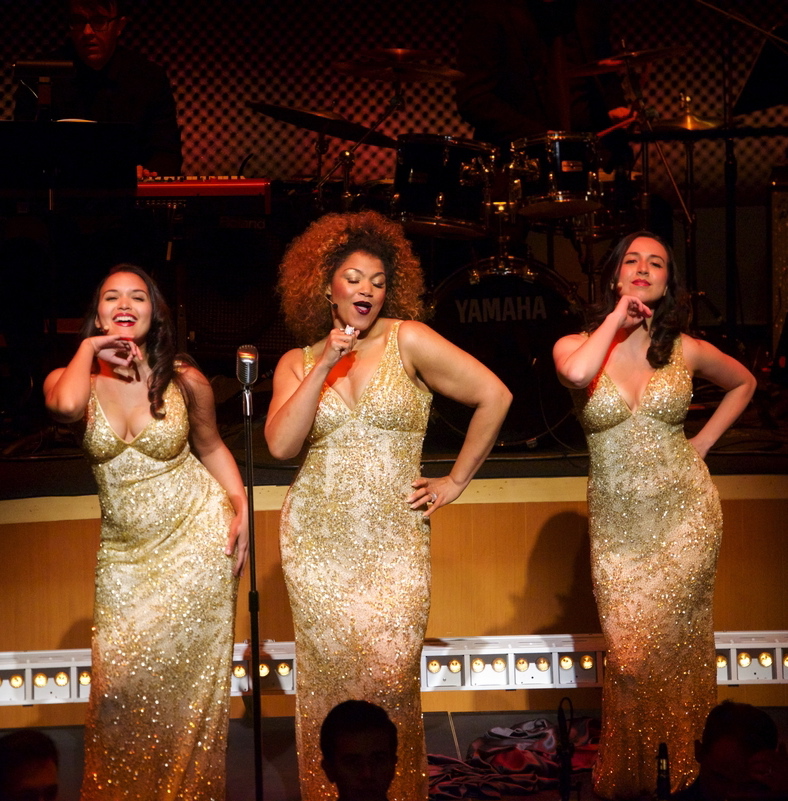New World unveils three world premieres in “New Work” program

Measha Brueggergosman (center) with Mikaela Bennett and Kara Sainz performing the world premiere of Michael Tilson Thomas’s “Four Preludes on Playthings of the Wind” at the New World Symphony Saturday night. Photo: Gregory Reed
An important addition to the two-piano repertoire and a compelling setting of a text by one of America’s greatest poets highlighted the New World Symphony’s annual “New Work” concert Saturday night. A significant number of younger listeners were part of the large audience that nearly filled the New World Center in Miami Beach for this adventurous program. All three of the works presented were receiving their world premieres.
Pianist-composer Timo Andres has won considerable acclaim for his forays into both classical and jazz genres. His Tides and Currents for two pianos and percussion utilizes the same forces as Bartok’s sonata of 1937, and this New World commission is a worthy successor to that unique score.
A series of alternately fierce and quiet episodes parallel the rise and fall of oceanic waves. The work opened with Andres playing a Bachian keyboard line which becomes ever more expansive in sonority and thematic construction as mallet percussion adds harmonics to the basic material. There are allusions to cool jazz when the percussionists play rhythmic and melodic patterns in synch with the two pianos.
Playing the score from an iPad, Andres was deft, elegant and boundless in virtuosity as he navigated the challenging figurations and timbral contrasts. New World fellow John Wilson matched him in pianistic dexterity and musicianship. Matthew Howard and Stephen Kehner brilliantly traversed the ebb and flow of the explosive and sensuous percussion writing. This masterful score deserves to join the standard duo-piano canon.
Stereo I Blind is a 15-minute mini-drama, a collaboration between playwright Lauren Yee and composer Amy Beth Kirsten. The tale of Anne, a young girl who is going progressively blind, and her mother who attempts to train her to use sound as a new means of sight is a retread of William Gibson’s The Miracle Worker. Whether deliberate or not, Yee’s text ultimately feels like a tired retread of conversations between Helen Keller and Anne Sullivan in that play and film. One could almost see Patty Duke and Anne Bancroft.
Kirsten’s score (for five violins and one double bass), however, effectively mirrors Anne’s journey from bewilderment and despair to her newfound ability to navigate both her environment and life itself. At first terse and jittery, the music turns lush and neo-romantic as sound becomes her strongest sensory perception.
Diana Oh was a mesmerizing Anne, channeling her desperation as she gets lost in the rain attempting to find the neighborhood library; then slowly finding a new way to live with dignity and self reliance. Dawn McGee was a strong stage presence, making the most out of the mother’s stilted dialogue.
The evening’s main event was the premiere of artistic director Michael Tilson Thomas’ Four Preludes on Playthings of the Wind. Set to a poem by Carl Sandburg, Tilson Thomas first began working on the score in the American bicentennial year of 1976. Continually making revisions over nearly three decades, he finally completed this audacious work, which is scored for soprano, two female backing voices, bar band and chamber orchestra this year.
In many ways the piece is an overview of the musical influences that have informed Tilson Thomas’ life and musical career. He cited Sarah Vaughan, Leontyne Price, James Brown and Igor Stravinsky as inspirations. The aura of Gershwin is also strongly present. A moody, ominous bass clarinet solo opening suggests that American master and the thematic material in the prelude pervades the entire score in multiple complex transformations. Tilson Thomas manages to keep the work’s changing musical landscape from becoming jarring. The wedding of art song, bebop and spiky modernism is achieved with assurance and a strong sense of dramatic momentum. The entire score celebrates indigenous American musical styles without copying Copland or his circle.
Sandburg’s poem speaks of a gleaming city and great nation which has decayed to the point where it is only inhabited by crows, rats and lizards. Canadian soprano Measha Brueggergosman was a vocal and theatrical force of nature. Wandering the stage as a modern day Cassandra warning of civilization’s ultimate deterioration and destruction, Brueggergosman shifted from dusky-voiced blues to rich and vibrant operatic soprano with an extended range that goes deep into mezzo territory.
Her command of such stylistic diversity was most impressive. In the score’s final pages, she sounded an eloquent and tragic note, the music’s shifting moods coming full circle. Mikaela Bennett and Kara Sainz were her exuberant backup singers, seeming to emerge from a nightclub out of Hades.
Seated on a platform behind the orchestra, the bar band consisted of pianist Wilson and eight top notch students from the University of Miami’s Frost School of Music (including two rhythm guitars and electric bass). Miles Jacques’ tonal refulgence and control in the opening bass clarinet solo and the polished and dynamic playing of the New World fellows gave first class advocacy to Tilson Thomas’ musical odyssey.
Donna Granata’s flashy costumes, Adam Larsen’s projections of glowing urbanism and its final destruction and James Darrah’s spiffy direction added atmospheric visuals to the musico-theatrical panorama.
Posted in Performances
Leave a Comment
Sun May 1, 2016
at 2:57 pm
No Comments




